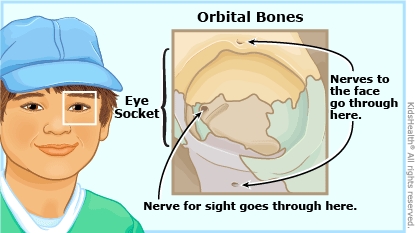Orbital Fracture: How to Care for Your Child
An orbital fracture is a break in one or more of the small bones around the eye that form the eye socket. They happen from a strong blow to the face, usually to the eyebrow and cheek. Treatment depends on the size and location of the break and whether there is also an injury to the eye or nearby muscles, nerves, or tissues. Sometimes surgery is needed.
Your child is ready to go home, but it's very important to follow all your health care provider's recommendations so your child gets the care they need.


Follow your health care provider's recommendations for:
-
Seeing any specialists, such as an ophthalmologist (eye doctor), plastic surgeon, neurosurgeon (brain and spinal cord doctor), or otolaryngologist (ENT, an ear, nose, and throat doctor).
-
Giving your child any prescription medicines.
-
Giving any pain medicines. This may include acetaminophen (such as Tylenol® or a store brand), ibuprofen (such as Advil®, Motrin®, or a store brand), or prescription pain medicine. Some pain medicines include the same or similar ingredients. To avoid giving too much, give the medicines exactly as recommended.
-
To help with swelling:
-
Have your child sleep sitting up or with the head propped on pillows.
-
Gently put a cold pack wrapped in a towel over your child's eye for 10 minutes several times each day. Do not apply ice directly to the skin or eye, and do not press against the eye.
-
Be sure your child does not blow their nose or sniff.
-
Your child should sneeze with the mouth open.
-
Your child should not play sports, do rough play, or go to gym class until your health care provider says it's OK.

Your child has:
-
pain that gets worse
-
discharge from the eye
-
fever

Your child has:
-
trouble seeing or blurry vision
-
trouble moving the eye
-
swelling that causes the eye to bulge from its socket
-
worsening redness or swelling around the eye
-
nausea, vomiting, or a severe headache

How do orbital fractures happen? The bones of the face are strong, so it takes a lot of force to break them. Orbital fractures can happen from car accidents, falls, or getting punched or hit forcefully with an object.
What are the symptoms of an orbital fracture? An orbital fracture causes pain, bruising, and swelling around the eye. Someone also might have a nosebleed, double vision, trouble opening the eyelid (due to swelling), trouble moving the eye around, less feeling on one side of the cheek or nose, or less feeling in some of the teeth.